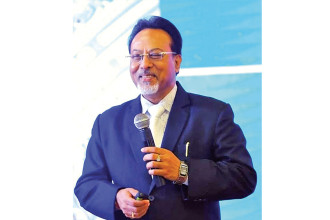
Anupa Rimal Lamichhane
Regional Manager, Asia-Pacific
Division of Country Programming, Green Climate Fund, South Korea
The Independent Power Producers’ Association, Nepal organised the eighth edition of the Power Summit 2023 in Kathmandu on April 18 and 19 which saw the participation of nearly 800 participants, including almost 300 international participants from over 30 countries. The theme for this year’s summit was ‘Broadening Green Energy Markets’. The two-day summit covered a wide range of issues including the energy market for Nepal, regulatory framework, and the need to also look at solar energy besides hydropower. Anupa Rimal Lamichhane, Regional Manager, Asia-Pacific – Division of Country Programming, Green Climate Fund, South Korea, who leads the climate finance portfolio in the region by maintaining and establishing long-term collaborations with countries and national stakeholders, was also present during the summit. Business 360 had the opportunity to speak to her about the overall energy sector of Nepal and GCF’s contribution to the country. Excerpts.How do you view the development of the energy sector in Nepal in terms of governance, finance and project types?
Based on my previous experiences of working in Nepal in the energy sector and now with the Green Climate Fund (GCF) to support the Government of Nepal to access climate finance for adaptation and mitigation measures, I think the government has made significant progress in recent years on several fronts. They have increased funding, improved governance in green and renewable energy, and implemented various energy projects. There is still a lot to be done. However, the energy sector promises to develop further with strong governance, capable institutions, and enabling policies and the environment. International assistance in the form of financial, technological, and capacity-building support can also help. For example, the establishment of regulatory bodies such as the Nepal Electricity Regulatory Commission (NERC) and the Alternative Energy Promotion Centre (AEPC) were major achievements for Nepal. These entities are responsible for regulating and promoting the development of the energy sector, ensuring fair practices, and fostering a conducive environment for investments. AEPC, which was established in 1996, is now an Accredited Entity at GCF and has successfully brought climate financing for projects to Nepal.Do you see any prospects of Nepal being at the centre of regional power trade in South Asia?
With its geography and location, Nepal has the potential to play a significant role in regional power trade in South Asia. The country is endowed with abundant hydropower resources, which can be harnessed to meet its own electricity needs and to export electricity to neighbouring countries. However, being a central stage of power trade at the regional level would require, among others, investment in diverse and accessible energy infrastructure, prioritising environmental and social sustainability, and strong cooperation and cohesion with countries in the region. Investment from both public and private sectors are critical. Private sector participation can be encouraged through favourable policies and incentives, as well as engagement with neighbouring countries to establish regional power trade agreements and explore opportunities to leverage Nepal’s hydropower potential for reliable and clean energy. Likewise, introduction of policy reforms and creation of a conducive environment for power trade is key. Lastly, investment in human resources development and strengthening capacity of power sector professionals is a vital piece.Is there a private sector window in GCF?
GCF has a private sector window designed to facilitate private sector engagement and investment in climate projects that promote low-emission and climate-resilient development in developing countries. Private sector organisations accredited to GCF can leverage GCF resources directly for investment projects that are aligned with national climate strategies and/or priorities and GCF’s investment criteria. Projects can include renewable energy projects, energy efficiency initiatives, climate-smart agriculture, and other climate-related activities. GCF offers flexible financial instruments to partners, such as loans, grants, equity, and guarantees.Addressing the disproportionate impact of climate change on women and empowering them as changemakers in climate adaptation is crucial for building a sustainable and equitable future. Gender policy is one of the critical elements in GCF’s programming architecture.Private sector organisations must engage with the National Designated Authority or Focal Point designated by the country to access GCF resources. These authorities act as the primary interface between governments and GCF during project development, approval, and implementation.Bottom of Form
How challenged is Nepal in terms of climate change and how does GCF work with Nepal to mitigate these risks?
Nepal is one of the most vulnerable countries impacted by climate change. Melting glaciers, increased frequency and intensity of climate-induced disasters like floods, landslides and droughts, food security and agricultural impacts, biodiversity loss, ecosystem degradation – the issues are escalating every year. These challenges impact people’s lives, vulnerable communities, and the country’s economy. GCF can support the government to address, adapt and mitigate these risks. In addition to investments for adaptation and mitigation projects, GCF provides technical assistance through our Readiness Programme to get countries ready to access and implement climate finance. As of now, Nepal has four in-country readiness grants and one regional readiness grant from GCF totalling $5.52 million for adaptation planning, access to climate finance, and project development. Nepal has received a total of $87.83 million from GCF for three projects, one of which directly targets providing clean energy to local communities.
How do you view the Power Summit 2023 that recently concluded in Nepal? What were some of the key takeaways?
I was glad to have the opportunity to join the Power Summit 2023 in-person and participate in the ‘Availability of Green Financing’ panel discussion with a wide range of stakeholders, including ministers, high-level government officials and the private sector. As the Power Summit was focused on the hydropower sector, sustainability, financing, and renewable energy were key themes in addressing the climate crisis. The summit was a great platform to network among key stakeholders and the panel discussions described the challenges and opportunities in the energy sector, including systemic and institutional issues to be addressed in order to meet the current demands of Nepal and the region. The summit highlighted policy gaps and regulatory reforms deemed necessary for the region if countries are to expand transformative, innovative and technologically advanced projects. The summit highlighted capacity constraints, the need for opportunities for technology transfer within the region and from beyond, and more focus on new research, which is extremely crucial. Lastly, the summit provided a pathway to continue efforts and open new doors for green energy in Nepal. This is a critical step to support the country’s commitment to achieving its NDC (Nationally Determined Contribution) and becoming a net-zero country by 2045.Climate change impacts women more and in many ways. How can we elevate women to become changemakers while enabling them to lead solutions to climate adaptation? Is this on the agenda of GCF?
Addressing the disproportionate impact of climate change on women and empowering them as changemakers in climate adaptation is crucial for building a sustainable and equitable future. Gender policy is one of the critical elements in GCF’s programming architecture. GCF strongly encourages engaging women in the entire project cycle in mitigation and adaptation projects. GCF emphasises the importance of women empowerment, including self-empowerment in decision-making, leadership, social, economic, and political empowerment, financial inclusion, participation, representation, access to technology, capacity building, advocacy and awareness, among others. Nepal can focus on strategies towards empowering women as changemakers, enabling their leadership in climate adaptation and various areas indicated above to build a more inclusive and resilient society to address the impact of climate change.What is the status of the climate finance projects GCF signed with Nepal in 2019?
GCF approved three projects in Nepal. In 2019, GCF approved the first project in Nepal, ‘Building a Resilient Churia Region’, which was signed in 2019 and is currently under implementation by FAO (Food and Agricultural Organisation). This project has an integrated approach in restoring the ecosystem while considering land use needs. It also has strong stakeholder engagement with all levels of government and community-based organisations. In 2020, GCF approved another project, which is to improve the resilience of vulnerable communities and ecosystems in the Gandaki River basin. Managed by IUCN (International Union for Conservation of Nature), the project adopts an ecosystem-centred and community-based approach to address climate vulnerability barriers, including the lack of climate change information and poor regulatory frameworks and institutional structures. The third project was approved in 2021, which aims to mitigate GHG emissions through modern, efficient and climate-friendly clean cooking solutions in Nepal’s Terai region. Managed by AEPC, this project will contribute to Nepal’s efforts to shift towards clean fuels and cooking technologies.What are some of the bottlenecks GCF faces while working with governments of least developed countries such as Nepal?
When I was at the LDC5 Conference in Doha, it was incredible to hear about the progress achieved by LDCs so far. There is still a lot to do, but some LDCs have come a long way, and progress is imminent. Capacity building and development take time, it doesn’t happen overnight. It is essential to ensure consistent support if we want to see changes in areas of global importance. Nepal has received funding from GCF totalling $93.35 million for projects and Readiness grants. While a success, there are areas for development that can impede accessing resources and successful implementation of climate projects such as limitations in institutional capacity and financial resources, human resources and infrastructure, and coordination among agencies. These are universal issues that we can all strive to work together in improving.What are some key solutions that common people can adopt to reduce carbon footprint and fight climate change?
There are several things that individuals can do to reduce their carbon footprint. Some solutions are simple and can start at home. For example, reducing energy consumption by turning lights, appliances and electronics off when not in use; using energy-efficient bulbs and appliances; opting for clean energy transportation like EV vehicles, bicycles, and walking; and using renewable energy sources like solar panels. Most importantly, it is about behavioural change and the willingness to change and contribute to reducing our carbon footprint. Here, governments can play a critical role through enabling policies, appropriate regulatory frameworks, advocacy, and outreach to help implement these solutions more effectively. READ ALSO:
Published Date: June 27, 2023, 12:00 am
Post Comment
E-Magazine
RELATED Face 2 Face





